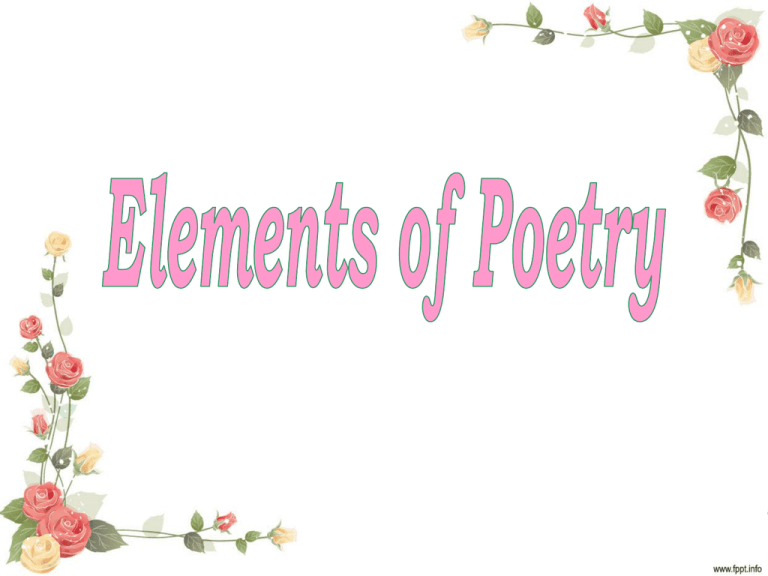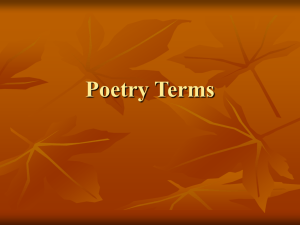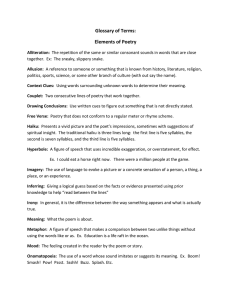Elements of Poetry
advertisement

Poetry Defined Poetry is literature in verse form, a controlled arrangement of lines and stanzas. Poems use concise, musical, and emotionally charged language to express multiple layers of meaning. The word poetry is derived from the Greek poiesis, meaning a “making” or “creating.” It is a form of art in which language is used. Figurative Language Language that is used imaginatively, rather than literally, to express ideas or feelings in new ways Figures of Speech 1. Similes: compares one thing to another and uses the words “like” or “as” 2. Metaphors: an implied comparison made between two unlike things 3. Personification: giving human traits (qualities, feelings, action, or characteristics) to non-human objects. Allusion: an allusion is the casual reference to a figure or event in history or literature that creates a mental image in the mind of the reader. Symbolism: the use of one object (a symbol) to represent or suggest something else Onomatopoeia: the use of words to represent sounds Imagery: Descriptive language that creates vivid impressions. These impressions, or images, are developed through sensory language, which provides details related to sight, sound, taste, touch, smell, and movement. Theme: the message of the poem Tone: the manner in which a poet makes his statement; it reflects his attitude toward his subject. The reader must learn to "hear" their tones with his mind's ear. Sound Devices Rhyme is the repetition of identical sounds in the last syllables of words. A pattern of rhyme at the ends of lines is a rhyme scheme. Rhythm the pattern created by stressed and unstressed syllables of words in sequence. A pattern of rhythm is called meter. Therefore, meter is a recurring pattern of stressed and unstressed syllables in lines of a set length. For example, suppose a line contains ten syllables (set length) in which the first syllable is unstressed, the second is stressed, the third is unstressed, the fourth is stressed, and so on until the line reaches the tenth syllable. The line would look like the following one (the opening line of Shakespeare’s “Sonnet 18") containing a pattern of unstressed and stressed syllables. The unstressed syllables are in blue and the stressed syllables in red: Shall I com PARE thee TO a SUM mer’s DAY? Each pair of unstressed and stressed syllables makes up a unit called a foot. The line contains five feet in all, as shown next: ....1.............. 2.................3..............4................ 5 Shall.I..|..com.PARE..|..thee.TO..|..a.SUM..|..mer’s DAY? •Meter is determined by the type of foot and the number of feet in a line. What is the number of feet per line? Upon a Lilac Sea by Emily Dickinson Upon a Lilac Sea To toss incessantly His Plush Alarm Who fleeing from the Spring The Spring avenging fling To Dooms of Balm Alliteration or initial rhyme, is the repetition of the initial consonant sounds of words, as in light and lemon. Assonance or vowel rhyme, is the repetition of vowel sounds in nearby words, as in the words date and fade. Consonance the repetition of consonants within nearby words in which the preceding vowels differ, as in the words milk and walk. Prosody 1. the science or study of poetic meters and versification. 2. a particular or distinctive system of metrics and versification 3. a poem’s “sound meaning,” its particular “flow” 4. Part of the flavor of the poetry is conveyed by the tempo of the words. Types of Poetry There are three main types of poetry. 1. Narrative poetry tells a story with a plot, characters, and a setting. •Epic is a long narrative poem about the feats of gods or heroes. •Ballad is a songlike narrative with stanzas and a refrain. 2. Dramatic poetry tells a story using a character’s own thoughts or spoken statement 3. Lyric poems express the feelings of a single speaker • Lyrics are the most common type of poem in modern literature. Poetic Structure Poems can also be categorized by structure, or form. Poetic structures are defined by patterns of line and stanza length, rhythm, and rhyme. Some examples are: Haiku is a verse form with three unrhymed lines of five, seven, and five syllables Free verse poems have neither a set pattern of rhythm or rhyme. Carpe diem is a Latin expression that means "seize the day." Carpe diem poems have the theme of living for today. Acrostic Poem tells about the word. It uses the letters of the word for the first letter of each line. Imagery Poems draw the reader into poetic experiences by touching on the images and senses which the reader already knows. Graphic Elements Poets use graphic elements to help readers to understand the poem and to strengthen the sound or visual appeal of the poem. Punctuation marks, such as commas, show the reader where to slow down or pause. Line length can help determine whether a poem has a flowing sound or a short, choppy sound. Word position can show relationships between words and ideas. Capital letters Capitalizing the first word in a line is one of the traditional tools of poetry writing, and using or not using it is a decision that a poet should make after some consideration. But whatever the decision, the practice today is clearly personal. Analyzing Poetry Analysis means literally picking a poem apart - looking at elements such as imagery, symbolism, allusion, metaphor, poetic language, rhyme scheme, and so on - in order to see how they all work together to produce the poem's meaning. Annotating is a great way to begin analyzing a poem. Annotating a Poem Annotation is the act of adding notes. STEP UP: S: Subject Matter – What is the poem about? Look at the title. T: Theme – What is the message of the poem? E: Emotions – Tone? Mood? P: Poetic Devices – Look for figurative language and sound devices. U: Your response – What do you think? P: Positioning – look at the graphic elements in the poem




